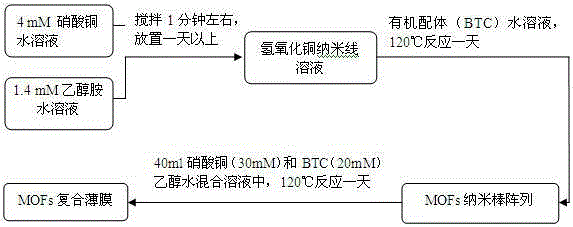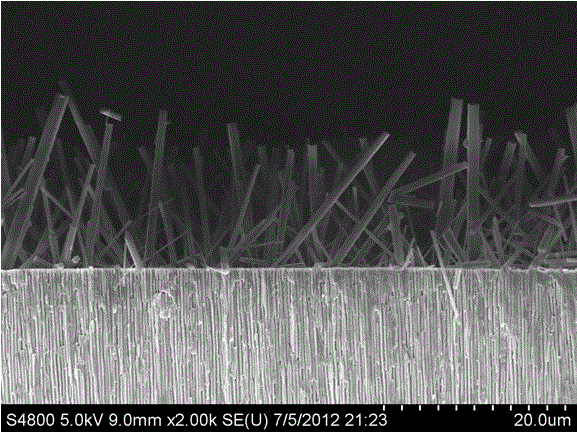Method for preparing metal-organic framework gas separation membranes by pinning metal-organic nanorod arrays on macroporous substrates
A nanorod array, metal organic frame technology, applied in semipermeable membrane separation, chemical instruments and methods, membrane technology, etc. Highly repeatable, adhesion-enhancing effect
- Summary
- Abstract
- Description
- Claims
- Application Information
AI Technical Summary
Problems solved by technology
Method used
Image
Examples
Embodiment 1
[0037] 1) Under magnetic stirring, add 1.4mM ethanolamine aqueous solution into the same volume of 4mM copper nitrate aqueous solution, after 1 minute, slow down the stirring speed, and seal the reaction vessel, after 12 to 36 hours, obtain the copper hydroxide nanowire solution, Filter 30ml of the nanowire solution directly to form a 900nm thick nanowire layer on the porous alumina membrane. The diameter of the porous alumina membrane is 2.5cm, the pore diameter is 200nm, and the porosity is 25-50%;
[0038] 2) Add the nanowire layer to 30ml of 1mM trimesic acid aqueous solution (pH=4), and react at 120°C for 24 hours to obtain a metal aluminum organic framework nanorod array, see figure 2 , image 3 ;
[0039] 3) Add the nanorod array to a mixed solution containing 40ml of copper nitrate, zinc nitrate or cadmium nitrate with a concentration of 30mM, 20mM trimesic acid, and ethanol water as the solvent, and react at 120°C for 6 to 24 hours to obtain a thickness of 25 μm The ...
Embodiment 2
[0041] 1) Under magnetic stirring, add 1.4mM ethanolamine aqueous solution into the same volume of 4mM copper nitrate aqueous solution, after 1 minute, slow down the stirring speed, and seal the reaction vessel, after 12 to 36 hours, obtain the copper hydroxide nanowire solution, Filter 30ml of the nanowire solution directly to form a 900nm thick nanowire layer on the porous alumina membrane. The diameter of the porous alumina membrane is 2.5cm, the pore diameter is 200nm, and the porosity is 25-50%;
[0042] 2) Add the nanowire layer to 30ml of 1mM trimesic acid aqueous solution (pH=4), and react at 120°C for 24 hours to obtain a metal aluminum organic framework nanorod array;
[0043] 3) Add the nanorod array to a mixed solution containing 40ml of 30mM copper nitrate, 20mM trimesic acid, and ethanol water as the solvent, and react at 120°C for 12 hours to obtain a 35μm thick metal-organic framework film, ethanol The volume ratio of ethanol to water in water is 1:1, see Fig...
Embodiment 3
[0045] 1) Under magnetic stirring, add 1.4mM ethanolamine aqueous solution into the same volume of 4mM copper nitrate aqueous solution, after 1 minute, slow down the stirring speed, and seal the reaction vessel, after 12 to 36 hours, obtain the copper hydroxide nanowire solution, Filter 30ml of the nanowire solution directly to form a 900nm thick nanowire layer on the porous alumina membrane. The diameter of the porous alumina membrane is 2.5cm, the pore diameter is 200nm, and the porosity is 25-50%;
[0046] 2) Add the nanowire layer to 30ml of 1mM trimesic acid aqueous solution (pH=4), and react at 120°C for 24 hours to obtain a metal aluminum organic framework nanorod array;
[0047] 3) Add the nanorod array to a mixed solution containing 40ml of 30mM copper nitrate, 20mM trimesic acid, and ethanol water as the solvent, and react at 120°C for 24 hours to obtain a 50μm thick metal-organic framework film, ethanol The volume ratio of ethanol to water in water is 1:1, see Fig...
PUM
 Login to View More
Login to View More Abstract
Description
Claims
Application Information
 Login to View More
Login to View More - R&D Engineer
- R&D Manager
- IP Professional
- Industry Leading Data Capabilities
- Powerful AI technology
- Patent DNA Extraction
Browse by: Latest US Patents, China's latest patents, Technical Efficacy Thesaurus, Application Domain, Technology Topic, Popular Technical Reports.
© 2024 PatSnap. All rights reserved.Legal|Privacy policy|Modern Slavery Act Transparency Statement|Sitemap|About US| Contact US: help@patsnap.com










